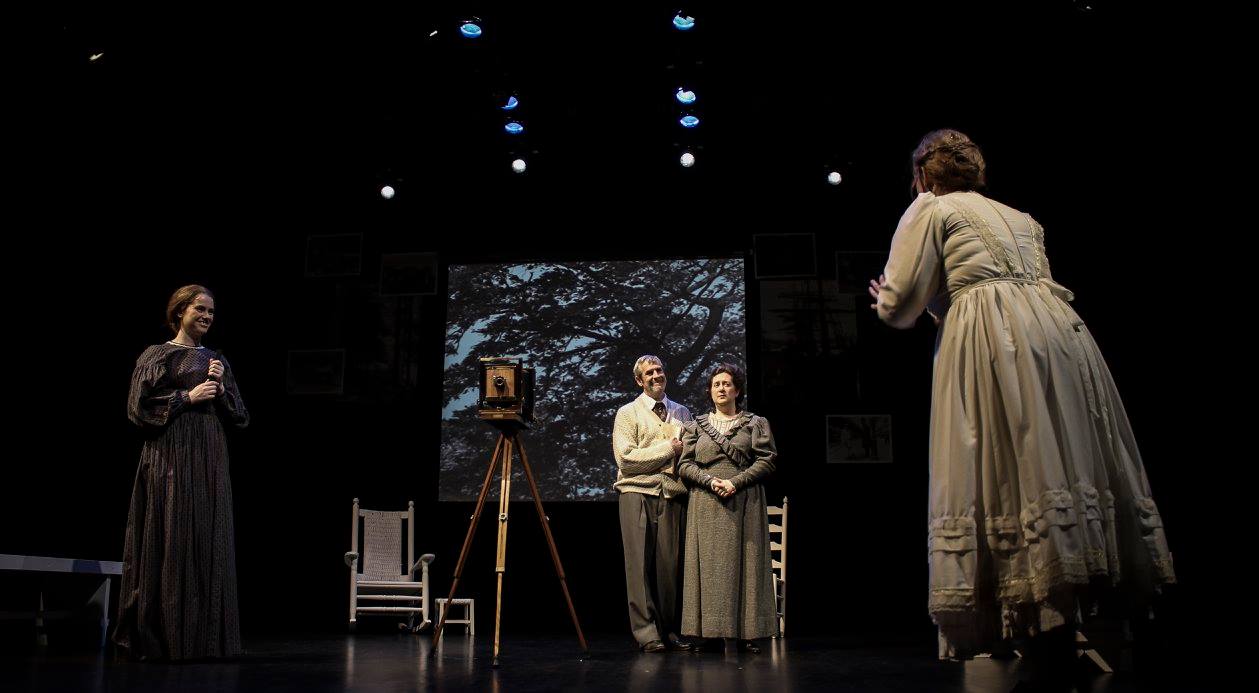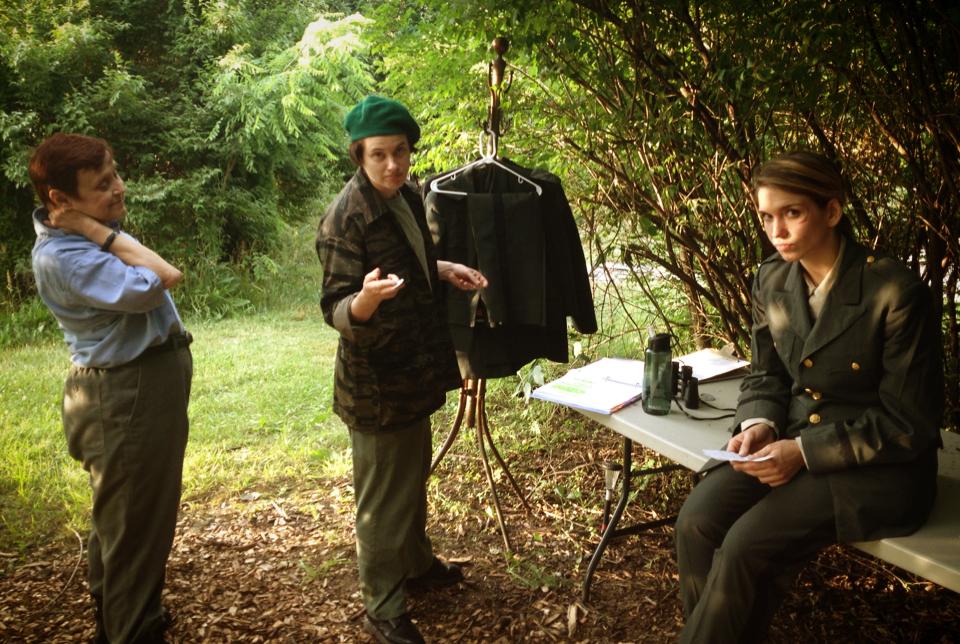Megan Adair, Ted Lesley, Shannon Woolley Allison, & Jennifer Thalman Kepler in Alice in Black & White. Photo by Holly Stone.
Alice in Black and White
By Robin Rice
Directed by Kathi E. B. Ellis
Review by Keith Waits
Entire contents copyright © 2017 Keith Waits. All rights reserved.
Only the most churlish misogynist would cast aspersions on the mission of Looking for Lilith for being limited. They have been investigating and uncovering significant historical stories about women for quite some time, and have yet to show no signs of exhausting that journey. Of course, new stories are being made each day, so they are always treading on fertile ground.
Alice in Black and White originated as an original production by Lilith in this same theatre some four years ago, was then revived in 2016 for a triumphant run in NYC; a milestone homecoming for the company, which began more than 15 years ago in the Big Apple. It is quintessential Lilith material, with the rich context of early feminist struggles in America, but it also carries those themes into the world of art and creativity, since Alice Austen was an important figure in the early development of photography and, more to the point, because she was a woman, an iconoclast.
She was also a lesbian, and at heart Robin Rice’s play is a love story between Alice and Gertrude Tate. While her family pushes her to marry and start a family, Alice beats male suitors at tennis and shows far more interest in her view camera. Only when she meets Gertrude does she begin to feel a desire for intimacy and passion. Typical for the time, it requires the passing of her family before it is possible for the two to live together.
The play details the family life with a stern, authoritarian mother (Shannon Woolley Allison), a transcendentalist grandfather (Ted Lesley in fine, New England character), and Aunt Minn (Megan Adair), and the carefree days of youth on the Staten Island family estate, Clear Comfort Farm, but Austen’s later years with Tate are grim and destitute, with the home in disrepair, Austen nearly crippled and Tate going blind.
Those dark scenes can be difficult to witness, and the pace is stately and determined, but Rice alternates time lines to show Oliver Jensen (Joseph Hatfield), an author in pursuit of Austen’s glass plate negatives for a book. He follows a lead to the Staten Island Historical Society and an indomitable receptionist, Sally Lally (Meg Caudill). The possibility that Jensen will rescue Austen’s work from obscurity, or perhaps even find Austen herself, provides the crucial narrative momentum of a detective story, which is especially important in the episodic, close–to-depressing later portion.
Not surprising given that this is the third go round, with most of the cast and crew intact from 2013, the performance and production values are supremely confident. Thalman-Kepler plays Alice from 11 to 85 with an impressive sensitivity for the detail and nuance of both the emotional and physical characteristics reflective of each point in her life. Laura Ellis is a charming and resolute Gertrude, while Ted Lesley gives a very specific dimension to grandfather John Austen in his brief time onstage, and solid professionalism in his utility work in other small roles. Shannon Woolley Allison also plays several people, and seems to have the most fun as a street person who guides Jensen to Clear Comfort Farm. Joseph Hatfield is fine as Jensen, even if it is the least developed role, dogged and obsessive but little else, his character is made more interesting by Meg Caudill’s unrequited affection towards him and how it leaks out slowly through the evening. And finally, Megan Adair plays her multiple roles with a supple, mercurial talent.
The design work – Scenic Design by Christie Lunsford, Costumes by Lindsay Chamberlin, and Lighting by Tom Willis, beautifully combine to make this a lovely production, with Austen’s photographs dominant in large screen projections. Nathan Roberts delivers effective music in his sound design that complements but never overwhelms. The aging of some characters is rendered primarily through the skill of the cast, but is also aided by nice attention to detail in the wigs and make-up.
The slow, deliberate pace might test the patience of generations accustomed to frenetically edited digital media, and, in truth, I wished for it to move a bit faster myself, yet it also seems right for the period and tone of the material, and the performances have more space to live and resonate as a result. Alice in Black and White tells of a desperate search into the past that reconnects us to the social change in flower at the turn of the 19th and 20th centuries.
Megan Adair, Shannon Woolley Allison, Meg Caudill, Laura Ellis, Joseph Hatfield, Jennifer Thalman Kepler, Ted Lesley
Alice in Black and White
March 9, 10, 11, 13*, 16, 17, 18 at 7:30p.m.
March 18 at 2p.m.
Tickets:
General Admission $21
Students/Seniors $16
*Community Night $11
Ask about rates for groups of ten or more
www.kentuckycenter.org/
or
502-584-7777
Audio Described performance March 10
ASL interpreted performance March 16
**By request only – two weeks notice**
Looking for Lilith Theatre
Kentucky Center for the Performing Arts
501 West Main Street
Louisville, KY 40202
Keith Waits is a native of Louisville who works at Louisville Visual Art during the days, including being the host of PUBLIC on WXOX-FM 97.1/ ARTxFM.com, but spends most of his evenings indulging his taste for theatre, music and visual arts. His work has appeared in Pure Uncut Candy, TheatreLouisville, and Louisville Mojo. He is now Managing Editor for Arts-Louisville.com.





